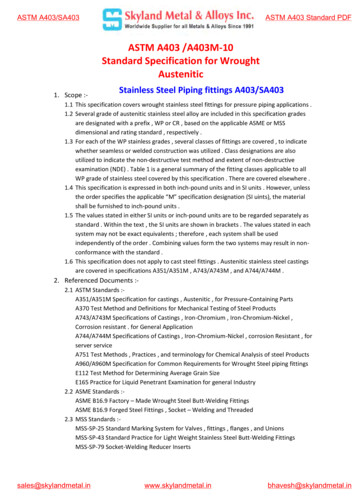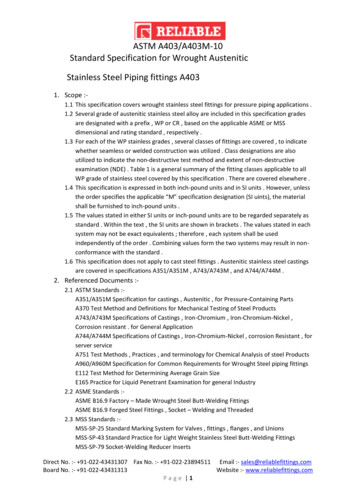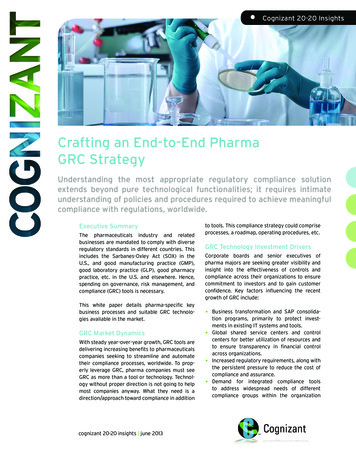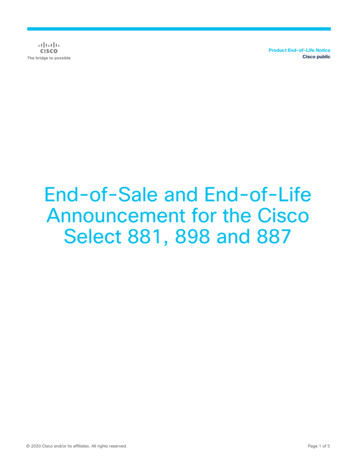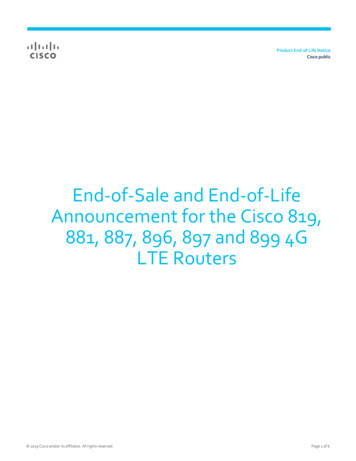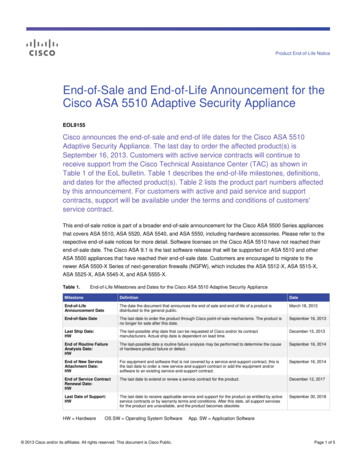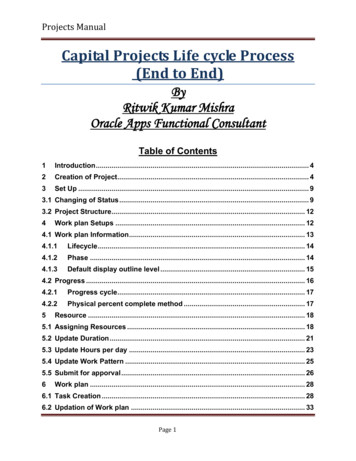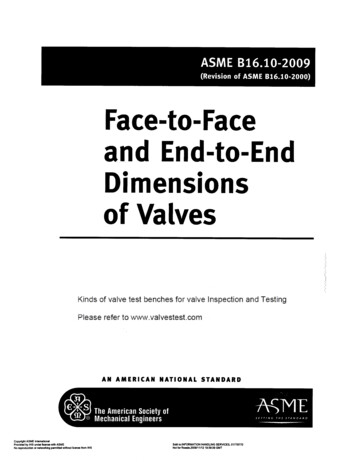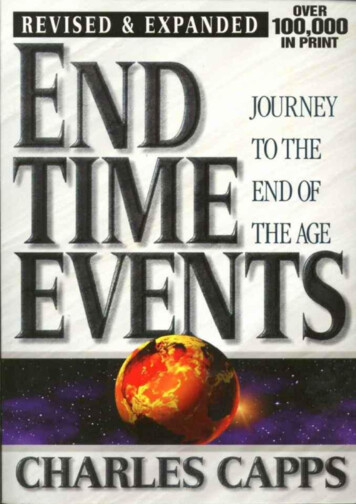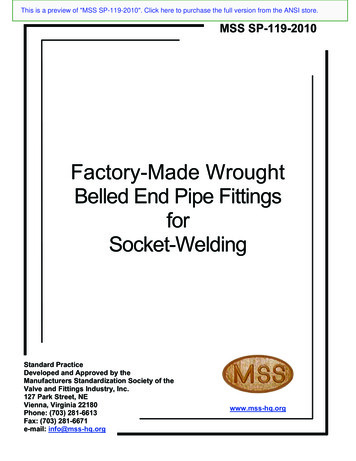
Transcription
This is a preview of "MSS SP-119-2010". Click here to purchase the full version from the ANSI store.MSS SP-119-2010Factory-Made WroughtBelled End Pipe FittingsforSocket-WeldingStandard PracticeDeveloped and Approved by theManufacturers Standardization Society of theValve and Fittings Industry, Inc.127 Park Street, NEVienna, Virginia 22180Phone: (703) 281-6613Fax: (703) 281-6671e-mail: info@mss-hq.orgwww.mss-hq.org
This is a preview of "MSS SP-119-2010". Click here to purchase the full version from the ANSI store.MSSSTANDARD PRACTICESP-119This MSS Standard Practice was developed under the consensus of the MSS Technical Committee 113 and theMSS Coordinating Committee. The content of this Standard Practice is the result of the efforts of competentand concerned volunteers to provide an effective, clear, and non-exclusive specification that will benefit theindustry as a whole. This MSS Standard Practice is intended as a basis for common practice by themanufacturer, the user, and the general public. The existence of an MSS Standard Practice does not in itselfpreclude the manufacture, sale, or use of products not conforming to the Standard Practice. Mandatoryconformance is established only by reference in a code, specification, sales contract, or public law, asapplicable."Unless otherwise specifically noted in this MSS Standard Practice, other standards referredto herein are identified by the date of issue that was applicable to this Standard Practice atthe date of issue of this Standard Practice. See Annex A. This Standard Practice shall remainsilent on the applicability of those other standards of prior or subsequent dates of issue eventhough applicable provisions may not have changed. References contained herein which arebibliographic in nature are noted as ‘supplemental’ in the text.”In this Standard Practice all notes, annexes, tables, and figures are construed to be essential to theunderstanding of the message of the Standard Practice, and are considered part of the text unless noted as"supplemental". All appendices, if included, that appear in this document are construed as "supplemental".Supplemental information does not include mandatory requirements for this Standard Practice.U.S. customary units in this Standard Practice are the standard; (SI) metric units are for reference only.This document has been substantially revised from the previous 1996 and 2003 editions. It issuggested that if the user is interested in knowing what changes have been made, that direct pageby page comparison should be made of this document.Any part of this Standard Practice may be quoted. Credit lines should read Extracted from MSS SP119-2010 with permission of the publisher, Manufacturers Standardization Society of the Valves andFittings Industry, Inc.'. Reproduction is prohibited under copyright convention unless writtenpermission is granted by Manufacturers Standardization Society of the Valve and Fittings Industry Inc.Originally Approved: November 1996Originally Published: January 1997Current Edition Approved: May 2010Current Edition Published: September 2010Copyright , 1997, 2003, 2010 byManufacturers Standardization Societyof theValve and Fittings Industry, Inc.Printed in U.S.A.i
This is a preview of "MSS SP-119-2010". Click here to purchase the full version from the ANSI store.MSSSTANDARD PRACTICESP-119FOREWORDASME B16.9 is the American Standard for steel butt-welding fittings and although not so stated, it isimplied that its scope deals primarily with standard (Schedule 40) wall and heavier as it was developedfor carbon steel and those grades of alloy steel piping that are selected for pressure and temperatureconsiderations. In 1949 ASME approved standard B36.19 for Stainless Steel Pipe in which Schedule 10Swas established. Schedule 5S pipe was recognized in the 1952 publication of B36.19. The companionfittings for Schedule 10S pipe used B16.9 shapes and proportions and were standardized by MSS SP-43,which was first published in 1950. In anticipation, the original 1950 edition of MSS SP-43 alsostandardized Schedule 5S fittings.Since 1950 the use of lighter than standard wall stainless steel piping in new construction has becomepredominant. The reasons for this evolution include the rapid expansion of the process industries in thefields of chemicals, plastics, textiles, paper, etc.Coincident with the greater utilization of light wall pipe and of more capable metal forming machinery,the need to reduce pipe assembly fabrication times brought about by world market competition led to thedevelopment of belled end socket welding fittings. As with the development of MSS SP-43, the shapesand proportions for B16.9 were reused for the belled end fitting bodies to the maximum extent possible.In 1992 first work on belled end fittings for this Standard Practice included defining socket proportions,socket to fitting body transition geometry, fitting thickness, and determining the ability of U.S. industryto support manufacturing. Some of this work only standardized service proven relationships used inbelled end fittings made for the pulp and paper industry without standards for over 20 years. In 1994 theU.S. Navy funded burst and fatigue testing prototype fittings in the first of a two-phase program. Thesecond phase was for an increased thickness fitting and was never done. In 1995 mid-way throughtesting, the Navy directed that these belled end fittings be used on ship systems in new constructionfollowed shortly thereafter by direction to use them on the repair of ship systems. The quality andconfiguration control of these fittings was done by an interim document, the requirements of which, withsome improvements, are contained herein.In keeping with trends wherein military procurement activities have been using more commercial materialstandards and because of recognized fabrication economies related to the use of these fittings, the U.S.Navy sponsored the writing of the 1996 edition of this Standard Practice in cooperation with fittingmanufacturers.This Standard Practice established dimensional uniformity for light wall belled end socket welding fittingdesigns qualified by burst and fatigue testing for Military Service and qualified by burst testing forCommercial Code Practice.The most significant changes in the 2003 revision included the following: 1) A new definition forallowable pressure ratings for MP fittings (Section 6), which adopts the B16.9 format rating the fittingthe same as the connecting pipe of the same schedule; 2) The addition of titanium and aluminum fittingmaterials; and 3) The addition of the Supplementary Requirements (Section 18, now 17), whichsupports Navy special requirements.The most significant changes in this 2010 revision include the following: 1) The extension of theSCOPE to include heavier wall fittings; 2) The relocation of the CR fitting requirements from the bodyof the Standard Practice to that of a Supplementary Requirement; 3) The addition of all thecombinations of reducing fittings included in B16.9; and, 4) The addition of a reference line on thesocket end to enable inspectors to measure the installation weld length – as a SupplementaryRequirement. The title of this 2010 revised Standard Practice has also been amended.ii
This is a preview of "MSS SP-119-2010". Click here to purchase the full version from the ANSI store.Manufacturers Standardization Societyof the Valve and Fittings Industry, Inc.“The Technical Voice of the Industry for Over 94 Years”127 Park Street, NE Vienna, VA 22180-4602 703-281-6613 Fax 703-281-6671 www.msshq.org E-mail: standards@msshq.orgEXECUTIVE DIRECTOR: D. E. ThompsonNovember 21, 2018ERRATA SHEET FOR MSS SP-119(Factory-Made Wrought Belled End Pipe Fittings for Socket-Welding)(Errata Sheet 1 for 2003 and Errata Sheet 2 for 2010 Edition)These “normative” errata corrections and clarifications apply to MSS SP-119-2010, Factory-Made Wrought BelledEnd Pipe Fittings for Socket-Welding as Errata Sheet 2 and MSS SP-119-2003, Factory-Made Wrought BelledEnd Socket-Welding Fittings as Errata Sheet 1.NOTE THE FOLLOWING CORRECTIONS AND/OR CLARIFICATIONS:Current 2010 Edition (Errata Sheet 2)General Clarification. The tolerance dimensions that are stated in MSS SP-119-2010 are the limit dimensions formanufactures and there is no rounding applied. The accuracy level of the dimensions and tolerances for themanufacturing of product, as stated, are to be the same degree of accuracy for measurements.For inspection (acceptance/rejection) purposes only, an inspector should match the accuracy level of the equipmentused and/or measurement taken with the specification and/or tolerance that is indicated within SP-119-2010; thus,standard or common rounding (half up) should be utilized if necessary to achieve a measurement reading with thesame degree of accuracy as the standard and then decide based on that final value. In addition, for inspection(acceptance/rejection) purposes, no trailing zeros shall be assumed as that affects the standardized and implieddegree of accuracy to be imposed by the inspector and the measuring device used.Previous 2003 Edition (Errata Sheet 1)Page 12, Table 3 (Socket Dimensions), Column C (CuNi Class 200) and Column C (All Other Materials). Inboth “C” Columns, delete all the existing zeros located as the third digit to the right of the decimal. For example,correct the current text “0.570” to “0.57”.General Clarification. The tolerance dimensions that are stated in MSS SP-119-2003 are the limit dimensions formanufactures and there is no rounding applied. The accuracy level of the dimensions and tolerances for themanufacturing of product, as stated, are to be the same degree of accuracy for measurements.For inspection (acceptance/rejection) purposes ONLY, an inspector should match the accuracy level of the equipmentused and/or measurement taken with the specification and/or tolerance that is indicated within SP-119-2003; thus,standard or common rounding (half up) should be utilized if necessary to achieve a measurement reading with thesame degree of accuracy as the standard and then decide based on that final value. In addition, for inspection(acceptance/rejection) purposes, no trailing zeros shall be assumed as that affects the standardized and implied degreeof accuracy to be imposed by the inspector and the measuring device used.This Errata Sheet has been inserted into the 2003 and 2010 editions of the Standard Practice. For those whoobtained the Standard Practice before the November 21, 2018 errata publication date indicated above or otherwisedo not already have this information, please include this Errata Sheet within your existing 2010 and/or previous2003 edition(s) of the Standard Practice. Future editions of this Standard Practice will include this correctedinformation.PRESIDENT: F. J. Washburn – Rotork Controls, Inc.VICE PRESIDENTS: J. E. Barker – DeZURIK APCO Hilton, Inc. D. Bayreuther – Metso Flow ControlTREASURER: P. Heald – Bonney Forge Corp.
This is a preview of "MSS SP-119-2010". Click here to purchase the full version from the ANSI store.Manufacturers Standardization Societyof the Valve And Fittings Industry, Inc.127 Park Street, NE Vienna, VA 22180-4602 703-281-6613 FAX 703-281-6671 www.mss-hq.org e-mail: info@mss-hq.orgEXECUTIVE DIRECTOR: Robert F. O’NeillERRATA SHEET FOR MSS SP-119-2010(Factory-Made Wrought Belled End Pipe Fittings for Socket-Welding)June 4, 2014These “normative” errata corrections applies only to MSS SP-119-2010 edition (current).NOTE THE FOLLOWING CORRECTIONS:1. Page 19, Table 9 (Reducing Branch Tee Dimensions). Correct “P” dimensions as follows:a. Size 21/2 x 21/2 x 11/4: Change to correctly read as “2.06”. This is consistent with previous versions.b. Size 21/2 x 21/2 x 11/2: Change to correctly read as “2.07”.2. Page 25, Table 15. Change title of table to correctly read as “Cap Dimensions”.Note that Table of Contents (page iii) is listed correctly.This Errata Sheet has been inserted into the Standard Practice. For those who obtained the StandardPractice before the June 4, 2014 errata publication date indicated above or otherwise do not already havethis information, please include this Errata Sheet within your existing 2010 edition of the Standard Practice.Future editions of this Standard Practice will include this corrected information.PRESIDENT: G.M. Johnson – United ValveVICE PRESIDENTS: M.A. Clark – NIBCO, Inc. F. Washburn – Rotork Controls, Inc.TREASURER: J. Barker – DeZURIK APCO, Inc.“The Technical Voice of the Industry”
This is a preview of "MSS SP-119-2010". Click here to purchase the full version from the ANSI store.MSSSTANDARD PRACTICESP-119TABLE OF CONTENTSSECTION1234567891011121314151617PAGESCOPE . 1REFERENCES . 1DEFINITIONS . 1CLASSIFICATIONS . 2PRESSURE RATINGS . 2FITTING DESIGN. 2MANUFACTURING METHOD PROOF TESTING . 3PRODUCTION TESTING . 4MATERIALS . 4WELDING A
End Pipe Fittings for Socket-Welding as Errata Sheet 2 and MSS SP-119-2003, Factory-Made Wrought Belled End Socket-Welding Fittings as Errata Sheet 1. NOTE THE FOLLOWING CORRECTIONS AND/OR CLARIFICATIONS: Current 2010 Edition (Errata Sheet 2) General Clarification. The tolerance dimensions that are stated in MSS SP-119-2010 are the limit dimensions for manufactures and there
